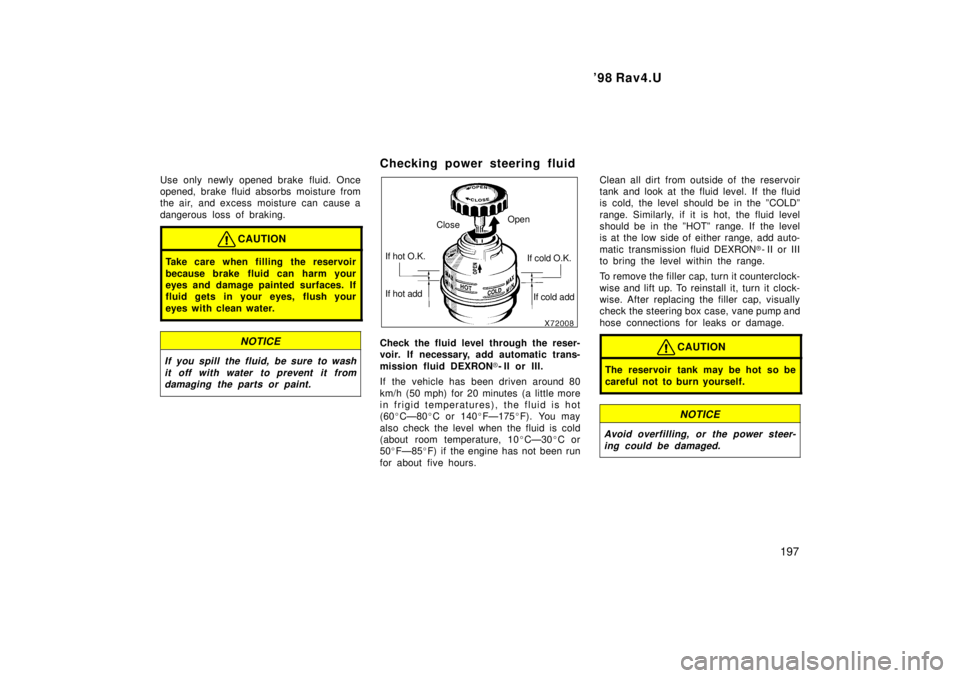Page 139 of 227

'98 Rav4.U139
Brake system
TANDEM MASTER CYLINDER BRAKE SYSTEM
The tandem master cylinder brake system
is a hydraulic system with two separate
sub- systems. If either sub- system s
hould
fail, the other will still work. However, the
pedal will be harder to press, and your
stopping distance will be longer. Also, the
brake system warning light may come on.
CAUTION
Do not drive your vehicle with only a
single brake system. Have your
brakes fixed immediately.
BRAKE BOOSTER
The brake booster uses engine vacuum to
power- assist the brakes. If the engine
should quit while you are driving, you can
bring the vehicle to a stop with normal
pedal pressure. There is enough reserve
vacuum for one or two stopsÐbut no
more!
CAUTION
� Do not pump the brake pedal if the
engine stalls. Each push on the
pedal uses up your vacuum reserve.
� Even if the power assist is com-
pletely lost, the brakes will still
work. But you will have to push the
pedal hardÐmuch harder than nor-
mal. And your braking distance will
be longer.
ANTI- LOCK BRAKE SYSTEM
(with ºABSº warning light)
The anti- lock brake system is designed to
automatically help prevent lock- up of the
wheels during sudden braking or braking
on slippery road surfaces. This assists in
providing directional stab ility and steering
performance of the vehicle under these
circumstances.
The anti- lock brake system becomes op-
erative after the vehicle has accelerated
to a speed in excess of approximately 10
km/h (6 mph). It stops operating when the
vehicle decelerates to a speed below
approximately 5 km/h (3 mph). You may hear a sound in the engine
compartment for a few seconds when the
engine is started or just after the vehicle
is started. This means that the anti- lock
brake system is in the self check mode,
and does not indicate a malfunction.
Effective way to press the ºABSº brake
pedal: When the anti- lock brake system
function is in action, you may feel the
brake pedal pulsating and hear a noise.
In this situation, to let the anti- lock
brake system work for you, just hold the
brake pedal down more firmly. Do not
pump the brake. This will result in re-
duced braking performance.
The brake pedal pulsation caused by the
anti- lock brake system may indicate haz-
ardous road surface conditions. Although
the anti- lock brake system assists in pro-
viding vehicle control, it is still important
to drive with all due care, because the
anti- lock brake system cannot overcome
the laws of physics that act on your ve-
hicle: � Braking capab ility is dependent on tire
friction with the road surface.
Page 197 of 227

'98 Rav4.U197
Use only newly opened brake fluid. Once
opened, brake fluid absorbs moisture from
the air, and excess moisture can cause a
dangerous loss of braking.
CAUTION
Take care when filling the r
eservoir
because brake fluid can harm your
eyes and damage painted surfaces. If
fluid gets in your eyes, flush your
eyes with clean water.
NOTICE
If you spill the fluid, be sure to wash
it off with water to prevent it fromdamaging the parts or paint.
Checking power steering fluid
Close Open
If hot O.K. If hot add If cold O.K.
If cold add
Check the fluid level through the reser-
voir. If necessary, add automatic trans-
mission fluid DEXRON �- II or III.
If the vehicle has been driven around 80
km/h (50 mph) for 20 minutes (a little more
in frigid temperatures), the fluid is hot
(60 �CÐ80 �C or 140 �FÐ175 �F). You may
also check the level when the fluid is cold
(about room temperature, 10 �CÐ30 �C or
50 �FÐ85 �F) if the engine has not been run
for about five hours. Clean all dirt from outside of the reservoir
tank and look at the fluid level. If the fluid
is cold, the level should be in the ºCOLDº
range. Similarly, if it is hot, the fluid level
should be in the ºHOTº range. If the level
is at the low side of either range, add auto-
matic transmission fluid DEXRON
�- II or III
to bring the level within the range.
To remove the filler cap, turn it c ounterclock-
wise and lift up. To reinstall it, turn it clock-
wise. After replacing the filler cap, visually
check the steering box case, vane pump and
hose connections for leaks or damage.
CAUTION
The reservoir tank may be hot so be
careful not to burn yourself.
NOTICE
Avoid overfilling, or the power steer-
ing could be damaged.
Page 218 of 227
'98 Rav4U
218
Engine
Model:
3S- FE
Type: 4 cylinder in line, 4 cycle, gasoline
Bore and stroke, mm (in.): 86.0
86.0 (3.39 3.39)
Displacement, cm 3
(cu. in.):
1998 (121.9) Fuel
Fuel type:
Unleaded gasolene, Octane Rating 87
(Research Octane Number 91) or
higher
Fuel tank capacity, L (gal., lmp. gal.): 58 (15.3, 12.8) Service specifications
ENGINE
Valve clearance (engine cold), mm (in.):
Intake 0.19Ð0.29 (0.007Ð0.011)
Exhaust 0.28Ð0.38 (0.011Ð0.015)
Spark plug type: DENSO PK20TR11
NGK BKR6EKPB11
Spark plug gap, mm (in.): 1.1 (0.043)
Drive belt tension measured with Bor-
roughs drive belt tension gauge No.
BT- 33- 73F (used belt), Ibf: Generator belt 95
20
Air conditioning
compressor belt 66
99
Power steering
pump belt 80
20
ENGINE LUBRICATION
Oil capacity (drain and ref ill),
L (qt., Imp. qt.): With filter
4.1 (4.3, 3.6)
Without filter 3.9 (4.1, 3.4)